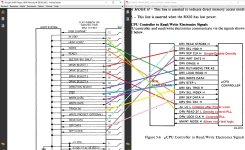BitWiz
Experienced Member
I'm trying to determine the purpose of the Density bit on the RX28 (M8357) Load Command Instruction (67X1)
Bit 03 is the density bit. However, I cannot see this bit used on either the RX8E or Roland's M8357R schematic anywhere and looking at the connections going to the RX02 drive itself, there is no density signal.
It is my impression that you select RX01 (single density) or RX02 (double density) with a dip switch on the controller board in the drive itself.
Am I wrong or just crazy?
Bit 03 is the density bit. However, I cannot see this bit used on either the RX8E or Roland's M8357R schematic anywhere and looking at the connections going to the RX02 drive itself, there is no density signal.
It is my impression that you select RX01 (single density) or RX02 (double density) with a dip switch on the controller board in the drive itself.
Am I wrong or just crazy?

